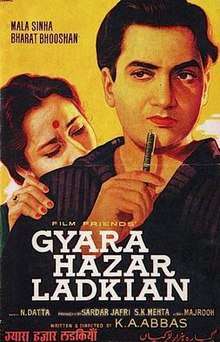Gyara Hazar Ladkian
Gyara Hazar Ladkian (Eleven Thousand Girls) is a 1962 Hindi romantic social drama film directed by K. A. Abbas.[1] The film was co-produced by the poet Ali Sardar Jafri, who also helped co-write the story with Abbas. Produced under the Film Friends banner, it had music by N. Dutta.[2] The director of photography was Ramchandra. The cast included Bharat Bhushan, Mala Sinha, Helen, Murad, Nadira and Madhavi.[3]
| Gyara Hazar Ladkian | |
|---|---|
 | |
| Directed by | K. A. Abbas |
| Produced by | K. A. Abbas Ali Sardar Jafri |
| Written by | K. A. Abbas Ali Sardar Jafri |
| Starring | Bharat Bhushan Mala Sinha Murad Nadira |
| Music by | N. Dutta |
| Cinematography | Ramchandra |
Production company | M/S Film Friends |
Release date |
|
Running time | 152 minutes |
| Country | India |
| Language | Hindi |
The story, which is told in flashback, involves a working girl Asha, played by Mala Sinha, who is in court for a murder committed by her younger sister. Bharat Bhushan plays the lawyer and journalist Puran, who takes the case to prove her innocence.
Plot
Asha (Mala Sinha) is in court facing a murder trial. Puran (Bharat Bhushan), a lawyer and journalist, takes the case. The story then goes into flashback, showing Asha working in the rationing office just after the war. She comes from a poor family and is the sole earning member. She also has six younger sisters to take care of. Puran comes from a rich family; his father is Seth Mulchand, a businessman. However, Puran decides to work for a newspaper, as a reporter. Asha likes Puran's articles exposing corruption and black-marketing, and his articles on working women. She gets interested in meeting the writer. The two meet in her office at her place of work. While leaving, Puran manages to drop his papers, and they get jumbled up with the papers on Asha's desk. Her paycheck, which was lying on the desk, is picked up by Puran by mistake along with his own papers. She meets Puran again to get her check back.
Following several meetings, Asha and Puran fall in love, which is disapproved of by Puran's father. Seth Mulchand tries bribing Asha to stay away from Puran, but she refuses. Seth has also attempted to get Puran to give up his journalism, but Puran is stubbornly defiant. An annoyed Seth then buys the newspaper where Puran works, but this results in Puran setting up his own newspaper. Seth then has Asha's youngest sister kidnapped and a ransom is demanded. Since Asha does not have the money for the ransom, she goes to Seth Mulchand. In lieu of the money she borrows, she signs a note stating that she's taking the money to leave Puran. This leads to misunderstandings between her and Puran. One of Asha's sisters, Uma (Madhavi), visits a club where she is molested by the owner. She ends up killing the club owner and Asha takes the blame. Puran manages to prove Asha's innocence in court and also clears up the rift created between them by his father.
Cast
- Mala Sinha as Asha
- Bharat Bhushan as Puran
- Nadira as Mohana
- Murad as Moolchand
- Baby Farida
- Baby Vidyarani
- Baby Vijay
- Soni Sultana
- Nirmala Mansukhani
- Minal
- Noor
- Helen as Dancer
Production And Review
Abbas chose Madhavi to play her debut role of the younger sister as he was certain that being a model, she would be able to face the camera confidently, and be the perfect foil for Mala Sinha's histrionics as the older sister. He had her trained for voice modulation and dialogue delivery to prepare her for the role.[4] The film was cited as "dull" and "boring" and termed as a "propaganda picture" in the Mother India magazine review.[5]
Soundtrack
One of the popular songs from the film was "Dil Ki Tamanna Thi Masti Mein", composed by N. Dutta. The lyricists were Majrooh Sultanpuri and Kaifi Azmi, while the playback singers were Mohammad Rafi, Asha Bhosle, Lata Mangeshkar and Mahendra Kapoor.
Songs
| Song | Singer |
|---|---|
| "Mere Mehboob Mere Saath Hi Chalna" | Mohammed Rafi |
| "Dil Ki Tamanna Thi Masti Mein" (Solo) | Mohammed Rafi |
| "Dil Ki Tamanna Thi Masti Mein" (Duet) | Asha Bhosle, Mohammed Rafi |
| "Gham Gaya Toh Gham Na Kar" | Asha Bhosle |
| "Sab Log Jidhar Woh Hai Udhar Dekh Rahe Hai" | Asha Bhosle |
| "Pehchano Hum Wohi Hain" | Lata Mangeshkar |
| "Gyara Hazar Ladkiyan" | Mahendra Kapoor |
References
- "Gyara Hazar Ladkian (1962)". gomolo.com. Gomolo.com. Retrieved 2 March 2015.
- Jerry Pinto (2006). Helen: The Life and Times of an H-bomb. Penguin Books India. pp. 233–. ISBN 978-0-14-303124-6. Retrieved 2 March 2015.
- "Gyara Hazar Ladkian". Alan Goble. Retrieved 2 March 2015.
- Khwaja Ahmad Abbas (1977). Mad, mad, mad world of Indian films. Hind Pocket Books. Retrieved 2 March 2015.
- Mother India. 29. Sumati. 1963. Retrieved 2 March 2015.